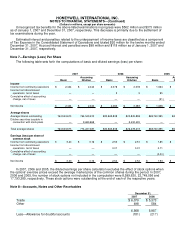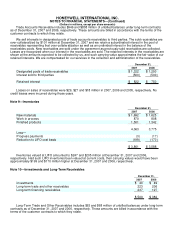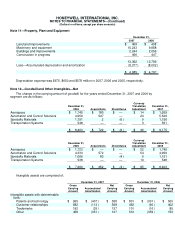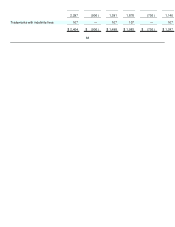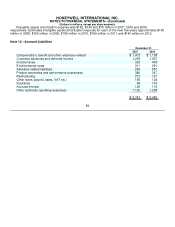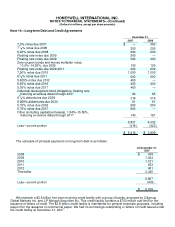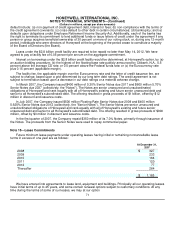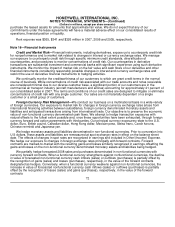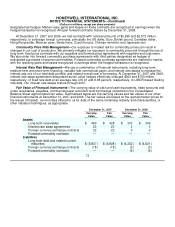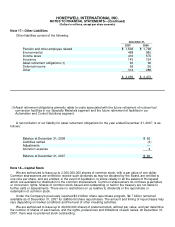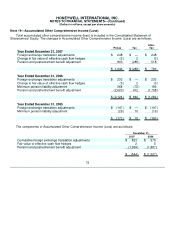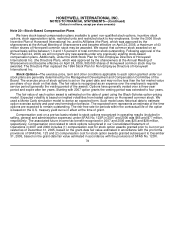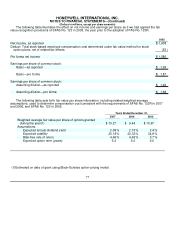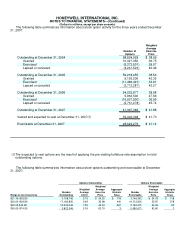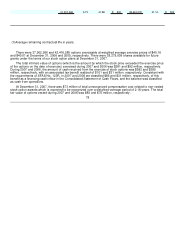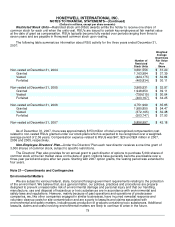Honeywell 2007 Annual Report Download - page 105
Download and view the complete annual report
Please find page 105 of the 2007 Honeywell annual report below. You can navigate through the pages in the report by either clicking on the pages listed below, or by using the keyword search tool below to find specific information within the annual report.
HONEYWELL INTERNATIONAL INC.
NOTES TO FINANCIAL STATEMENTS—(Continued)
(Dollars in millions, except per share amounts)
purchase the leased assets for amounts that approximate fair value. We do not expect that any of our
commitments under the lease agreements will have a material adverse effect on our consolidated results of
operations, financial position or liquidity.
Rent expense was $365, $341 and $326 million in 2007, 2006 and 2005, respectively.
Note 16—Financial Instruments
Credit and Market Risk—Financial instruments, including derivatives, expose us to counterparty credit risk
for nonperformance and to market risk related to changes in interest or currency exchange rates. We manage
our exposure to counterparty credit risk through specific minimum credit standards, diversification of
counterparties, and procedures to monitor concentrations of credit risk. Our counterparties in derivative
transactions are substantial investment and commercial banks with significant experience using such derivative
instruments. We monitor the impact of market risk on the fair value and cash flows of our derivative and other
financial instruments considering reasonably possible changes in interest and currency exchange rates and
restrict the use of derivative financial instruments to hedging activities.
We continually monitor the creditworthiness of our customers to which we grant credit terms in the normal
course of business. While concentrations of credit risk associated with our trade accounts and notes receivable
are considered minimal due to our diverse customer base, a significant portion of our customers are in the
commercial air transport industry (aircraft manufacturers and airlines) accounting for approximately 21 percent of
our consolidated sales in 2007. The terms and conditions of our credit sales are designed to mitigate or eliminate
concentrations of credit risk with any single customer. Our sales are not materially dependent on a single
customer or a small group of customers.
Foreign Currency Risk Management—We conduct our business on a multinational basis in a wide variety
of foreign currencies. Our exposure to market risk for changes in foreign currency exchange rates arises from
international financing activities between subsidiaries, foreign currency denominated monetary assets and
liabilities and anticipated transactions arising from international trade. Our objective is to preserve the economic
value of non-functional currency denominated cash flows. We attempt to hedge transaction exposures with
natural offsets to the fullest extent possible and, once these opportunities have been exhausted, through foreign
currency forward and option agreements with third parties. Our principal currency exposures relate to the U.S.
dollar, Euro, British pound, Canadian dollar, Hong Kong dollar, Mexican peso, Swiss franc, Czech koruna,
Chinese renminbi and Japanese yen.
We hedge monetary assets and liabilities denominated in non-functional currencies. Prior to conversion into
U.S dollars, these assets and liabilities are remeasured at spot exchange rates in effect on the balance sheet
date. The effects of changes in spot rates are recognized in earnings and included in Other/(Income) Expense.
We hedge our exposure to changes in foreign exchange rates principally with forward contracts. Forward
contracts are marked-to-market with the resulting gains and losses similarly recognized in earnings offsetting the
gains and losses on the non-functional currency denominated monetary assets and liabilities being hedged.
We partially hedge forecasted 2008 sales and purchases denominated in non-functional currencies with
currency forward contracts. When a functional currency strengthens against nonfunctional currencies, the decline
in value of forecasted non-functional currency cash inflows (sales) or outflows (purchases) is partially offset by
the recognition of gains (sales) and losses (purchases), respectively, in the value of the forward contracts
designated as hedges. Conversely, when a functional currency weakens against non-functional currencies, the
increase in value of forecasted nonfunctional currency cash inflows (sales) or outflows (purchases) is partially
offset by the recognition of losses (sales) and gains (purchases), respectively, in the value of the forward
contracts
72


